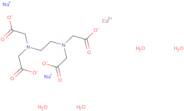
Ethylenediaminetetraacetic acid copper(II) disodium salt
CAS: 39208-15-6
Ref. 3D-PBA20815
| 2kg | A consultar | ||
| 5kg | A consultar | ||
| 10kg | A consultar | ||
| 25kg | A consultar |
Informação sobre produto
- Cuprate(2-), [[N,N′-1,2-ethanediylbis[N-(carboxymethyl)glycinato-κN,κO]](4-)]-, disodium
- Cuprate(2-), [[N,N′-1,2-ethanediylbis[N-(carboxymethyl)glycinato-κN,κO]](4-)]-, sodium (1:2)
- Cuprate(2-), [[N,N′-1,2-ethanediylbis[N-(carboxymethyl)glycinato]](4-)-N,N′,O,O′]-, disodium
- Disodium 2-[2-(4,8-Dioxo-1,3-Dioxa-6-Aza-2$L2-Cupracyclooct-6-Yl)Ethyl-(2-Oxido-2-Oxo-Ethyl)Amino]Acetate
- Disodium copper EDTA
- Disodium ((N,N'-ethylenebis(N-(carboxymethyl)glycinato))(4-)-N,N',O,O')cuprate(2-)
Ethylenediaminetetraacetic acid copper(II) disodium salt (EDTA-Cu) is a chemical compound that is used as an animal health additive. It is a diamine tetraacetic acid (DTA) complex of copper(II). EDTA-Cu has been shown to inhibit the corrosion of steel, aluminium and brass. It can also be used as a chelating agent to remove heavy metals from wastewater and sludge. EDTA-Cu can be added to water in order to produce an effervescent solution that helps prevent dental plaque formation by inhibiting the growth of bacteria in saliva. The hydrazone group in the molecule can form complexes with proteins, which are then excreted through the kidneys. EDTA-Cu has also been shown to have an inhibitory effect on carbon sources such as glucose and glycerol, which may help reduce weight gain in livestock animals fed high levels of these carbohydrates.
Propriedades químicas
Consulta técnica sobre: 3D-PBA20815 Ethylenediaminetetraacetic acid copper(II) disodium salt
Se desejar solicitar um orçamento ou fazer uma encomenda, por favor, adicione os produtos ao seu carrinho e depois solicite um orçamento ou encomenda a partir do carrinho. É mais rápido, mais barato e poderá beneficiar-se dos descontos e outras vantagens disponíveis.





